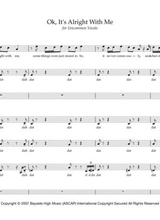Is That Alright Yeah Chords
Are you ready to rock? There's a new and exciting way to get your music fix, called "Is That Alright Yeah Chords." This new genre is all about picking the right chords to fit your song and sounding like you're in a band. It's great for building excitement for your live performance and getting feedback from your audience.

What is the difference between chords and melody
There are a few key differences between chords and melody. For starters, chords are often played as primary voices in a song, while melody is typically sung or played as accompaniment. Additionally, chords can also be strung together to create melodies, while melodies typically consist of a series of notes played together.
The four basic chords: A, Dm7, G7, and Ab6
chords are one of the most important pieces of music that people learn. They can be used in a variety of ways to create unique sounding music. This article is going to explore the four basic chords: A, Dm7, G7, and Ab6. These chords can be used in a variety of ways to create unique sounding music.
The four main modes: Ionian, Dorian, A minor, and Phrygian
In music, there are four main modes: Ionian, Dorian, A minor, and Phrygian. Each mode has a different soundscape and can be used to create unique pieces of music. is That Alright Yeah chords are one of the most popular types of chords in rock and metal. They're versatile and can be used to create an "alike" or "resemblance" chord for a song.
The three key intervals: 1/2, 3/4, and 5/8
In this article, we'll be discussing the three key intervals: 1 2, 3 4, and 5 8. This will help you better understand what they are and how to use them in your music. So let's get started!
1 2 – The 1-2-3 quartet is a common time signature that can be used in many styles of music. It's easy to remember because it has the same notes played twice in a row (1, 2, 3).
3 4 – The 3-4-5 chord contains all of the chords you've learned so far - just with different notes played at each fret. You can play it as open or arpeggiated chords. It's great formajor keys or if you want to add some extra interest to your songs.
The chords in a song: major, minor, and tertiary chords
Most people know the chords for major, minor, and tertiary chords. But what about those pesky chords in between? These are called "chords of half-step", or "chords in between." They're usually played as part of a song's foundation, as a way to add interest or variety. Here's a look at some of the most common chords in between:
Tertiary Chord #1: D7
This chord is found in many songs that feature a keyboards or orchestral sections. It's often used as the chord for the ending of a phrase or for starting another section. It can also be used as an interval in its own right.
Tertiary Chord #2: G7
This chord is typically used to add energy or life to a song. It can also be used to create a more intimate feel.
The chords in a strummed melody
There are many chords in a strummed melody. The chords that can be used in most songs are the major and minor chords. The major chord is the most common chord used in a strummed melody. The minor chord is also a common chord, but it is lessCommon than the major chord.
The chords that can be used in a strummed melody are usually based on the 1st, 2nd, or 3rd degree of the scale. The 1st degree of the scale is called the "root" chord. The 2nd degree is called a "secondary" chord. The 3rd degree is called a "tertiary" chord.
The chords that can be used in a strummed melody are usually based on some other riff or melody note. They may not be based on the root or secondary chords mentioned earlier.
Example: "Hey Jude" by John Lennon
John Lennon's song "Hey Jude" is often cited as one of the most iconic and well-known songs of all time. The song was written in 1967, during the heyday of the Beatles, and it has been performed by many performers throughout the years. It has also been used in various commercials and movies. Despite its popularity, there are some people who feel that "Hey Jude" is not actually their favorite song.
Conclusion
In the world of music, chords are one of the most important pieces. Whether you’re learning a new song or just playing along with something old, having a few chords in your arsenal can make a big difference. But is that really necessary?
Some people swear by using chords all the time and say they’re essential for singing and playing instruments. Others might only use them occasionally or not at all. Ultimately, it comes down to what works best for you and your own style of play.